It’s well-documented how much data is used in football these days.
Data plays a pivotal role in club decision-making, whether to guide recruitment or inform tactical decisions.
But how can data be used to benefit players?
Manchester City’s Kevin De Bruyne and Arsenal’s Ben White have been known to use the wealth of football data to negotiate improved contract terms.
One player who could equally benefit from such a data exercise is Trent Alexander-Arnold, a Liverpool and England international whose contract is due to expire in the summer.
According to the Capology website, the right-back is currently the third-highest earner on Liverpool’s books, behind Mo Salah and Virgil van Dijk.
With his deal coming to an end and no confirmation of a renewal finalised, the media has been abuzz with speculation linking the 25-year-old with Real Madrid.
But should the Reds let one of their own depart this summer for nothing or look to keep him at Anfield at all costs?
This data analysis and scout report will assess how Alexander-Arnold fits into new manager Arne Slot’s tactics and determine the value that the England international brings to his team.
We will further analyze what life could be like without Trent in the red half of Merseyside.
Where Trent Alexander-Arnold Fits In Arne Slot’s Tactics
Since Arne Slot was brought in to replace Jürgen Klopp, we’ve provided an extensive analysis of the Dutchman’s tactical approach, which you can read here at Total Football Analysis.
Slot has instilled patient, possession-based football while avoiding the pressing approach that had become synonymous with this Liverpool side in recent years.
A key element of Arne Slot’s coaching style is fluidity on the pitch; he demands positional flexibility from his playing personnel.
This is perfectly exemplified by Alexander-Arnold, who, in addition to covering his more traditional right-back role, will often invert to more central areas of the midfield to give Liverpool an edge in the attacking phases.
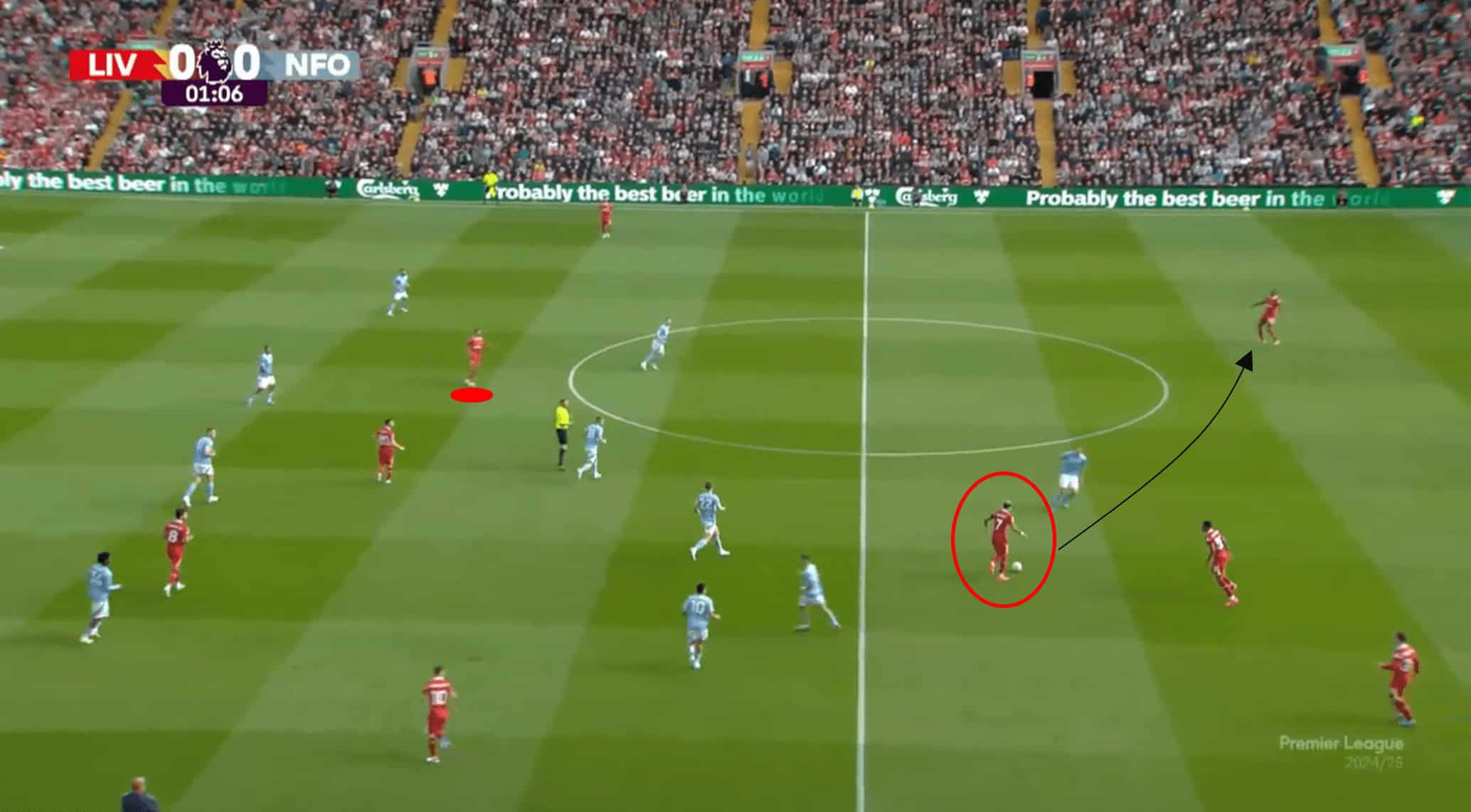
A classic example is shown above, where Liverpool have reverted to three at the back to facilitate Alexander-Arnold’s taking up a position much higher up the pitch toward the attacking third.
The winger Luis Díaz has inverted inside to a deeper position than what would be considered the norm for a forward player to stretch play out to the right-hand side.
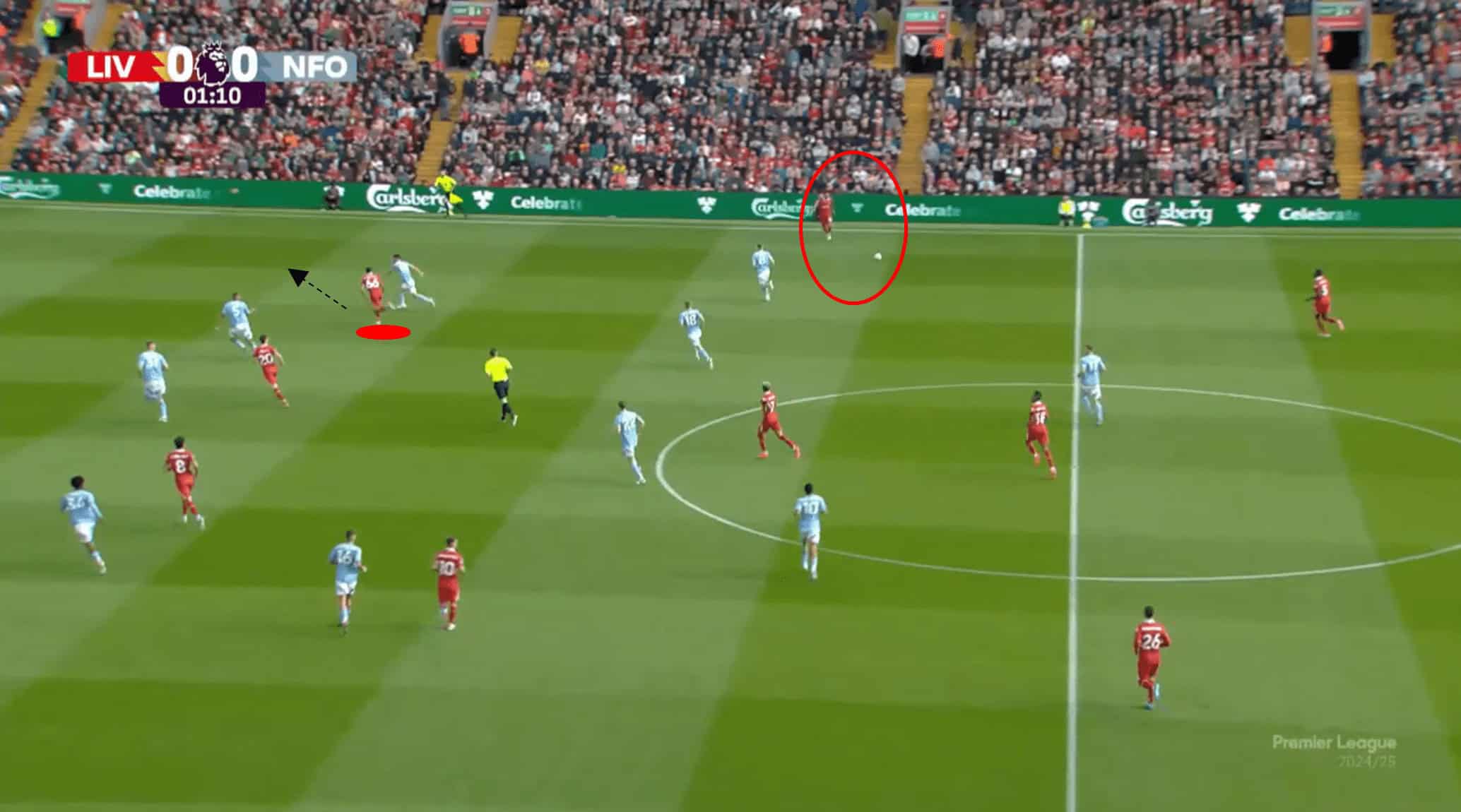
As Liverpool progressed in play, the defender was caught between Salah and Alexander-Arnold and was forced to backtrack as the Liverpool right-back made a run toward his more natural right channel to try to influence the Reds’ attack.
The England international is adept at delivering crosses into the penalty area.
At the time of writing, he has made 0.86 crosses into the penalty area per 90 minutes—the highest of any Liverpool player this season.
The England international has been given freedom in attacking transitions in one sense, but he has also had to be disciplined with his positioning
Trent Alexander-Arnold Heat Map
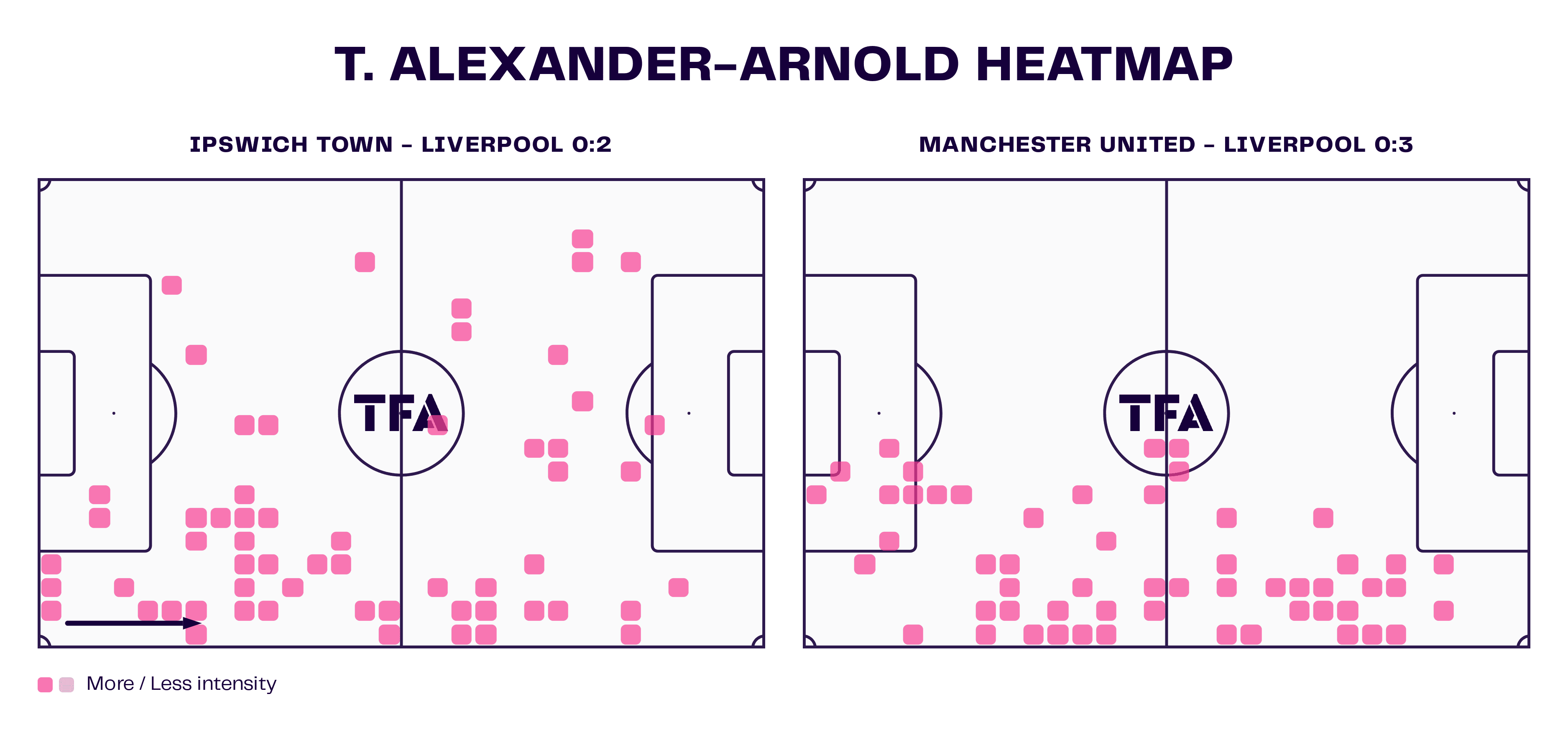
The heatmap above showcases Trent’s different positions in this campaign’s fixtures against Ipswich and Manchester United.
It is noticeable that, along with the tendency to drift inside during both fixtures, Alexander-Arnold was given much more licence in the final third against the Tractor Boys.
In comparison against United, the right-back did not find himself influencing the match in and around the penalty area quite so often – most likely as a product of Erik Ten Hag’s tendency to play his full-backs high.
Consequently, Alexander-Arnold needed to ensure that he was providing adequate defensive cover for his side, especially since United often adopt a quick, direct style of play.
Due to his pace, the 25-year-old has often been deployed to break up opposition counterattacks.
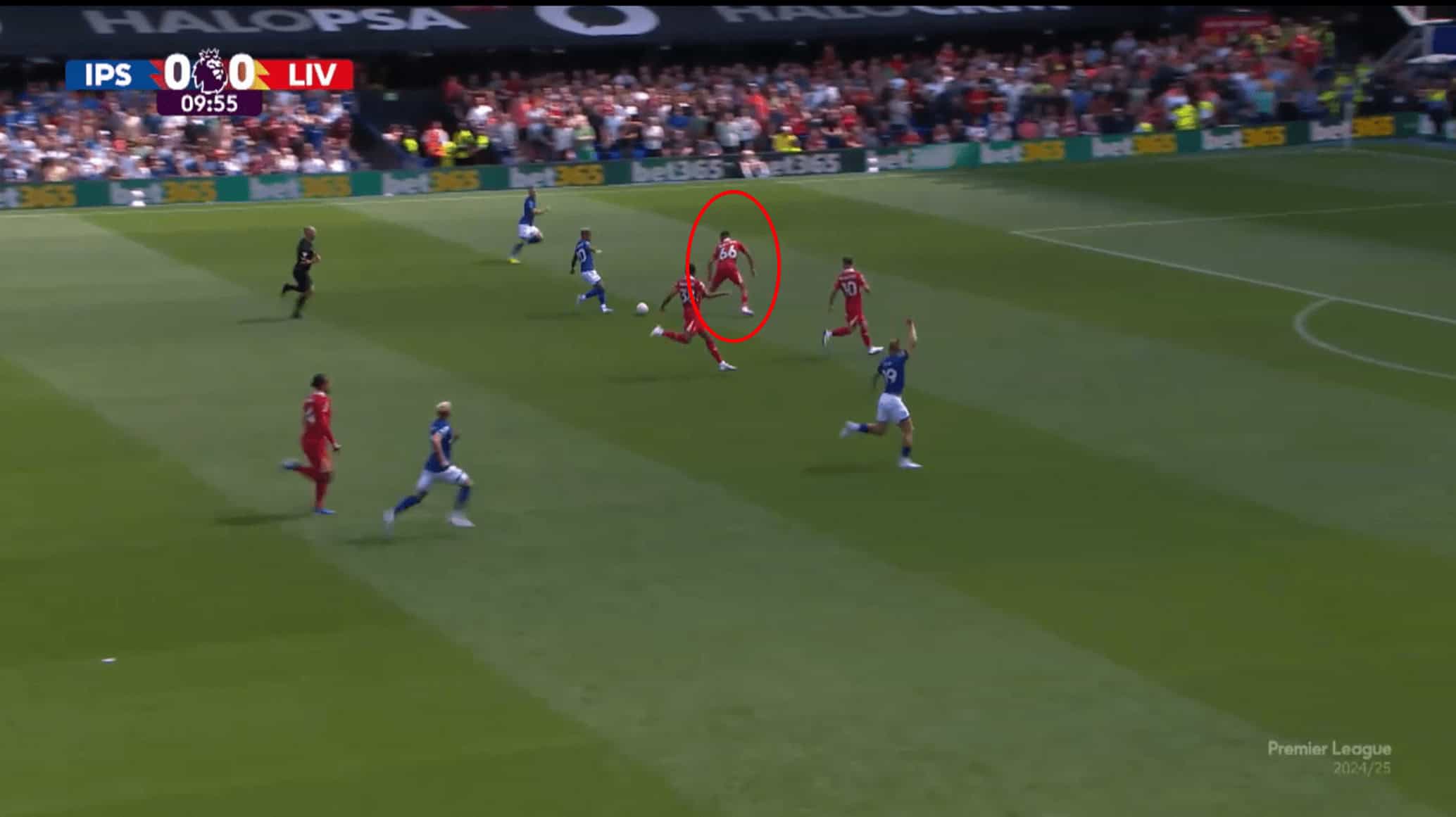
Take the above example, where Ipswich have launched a counter following a Liverpool set piece.
Alexander-Arnold successfully intercepts the pass and averts the danger for his side.
Trent undoubtedly gives Liverpool options, and his ability to adapt to different positions during a match causes the opposition headaches.
However, while we have determined Alexander-Arnold’s role in this Liverpool system so far, what value does he add?
Quantifying Trent Alexander-Arnold’s Value To Liverpool
If you were to think of the most valuable thing that an outfield player could do, it would probably be to score a goal.
However, goals rarely occur due to circumstantial luck and are more so a product of a team effort.
In simplistic terms, football can be thought of as a series of possession chains.
Possession will transition from one player to another, and the probability of a pass being successful is associated with each pass from a player to his respective teammate.
The diagram below showcases the possession chain for Liverpool’s opening goal against Ipswich this season.
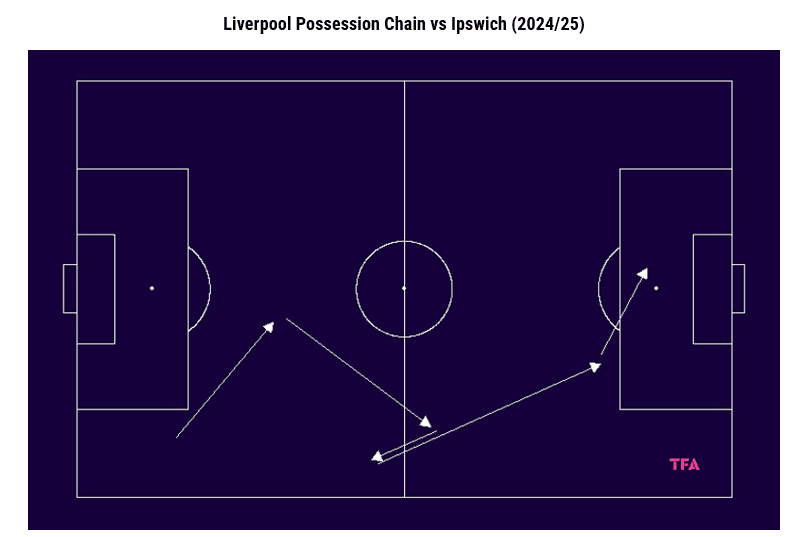
The above possession chain plot shows the different passes made in the build-up to the goal, with some covering a shorter distance than others.
It is conceivable that passes made over longer distances are likely to be associated with a higher difficulty level as the probability of successfully completing such long-distance passes is lower.
Alexander-Arnold made the pass along the right channel above, which is just one demonstration of the high-quality long-range progressive passes that the right back looks to make.
The graphic below shows the progressive passes that Alexander-Arnold has made in the Premier League this season.
Trent Alexander-Arnold Progressive Passes Map
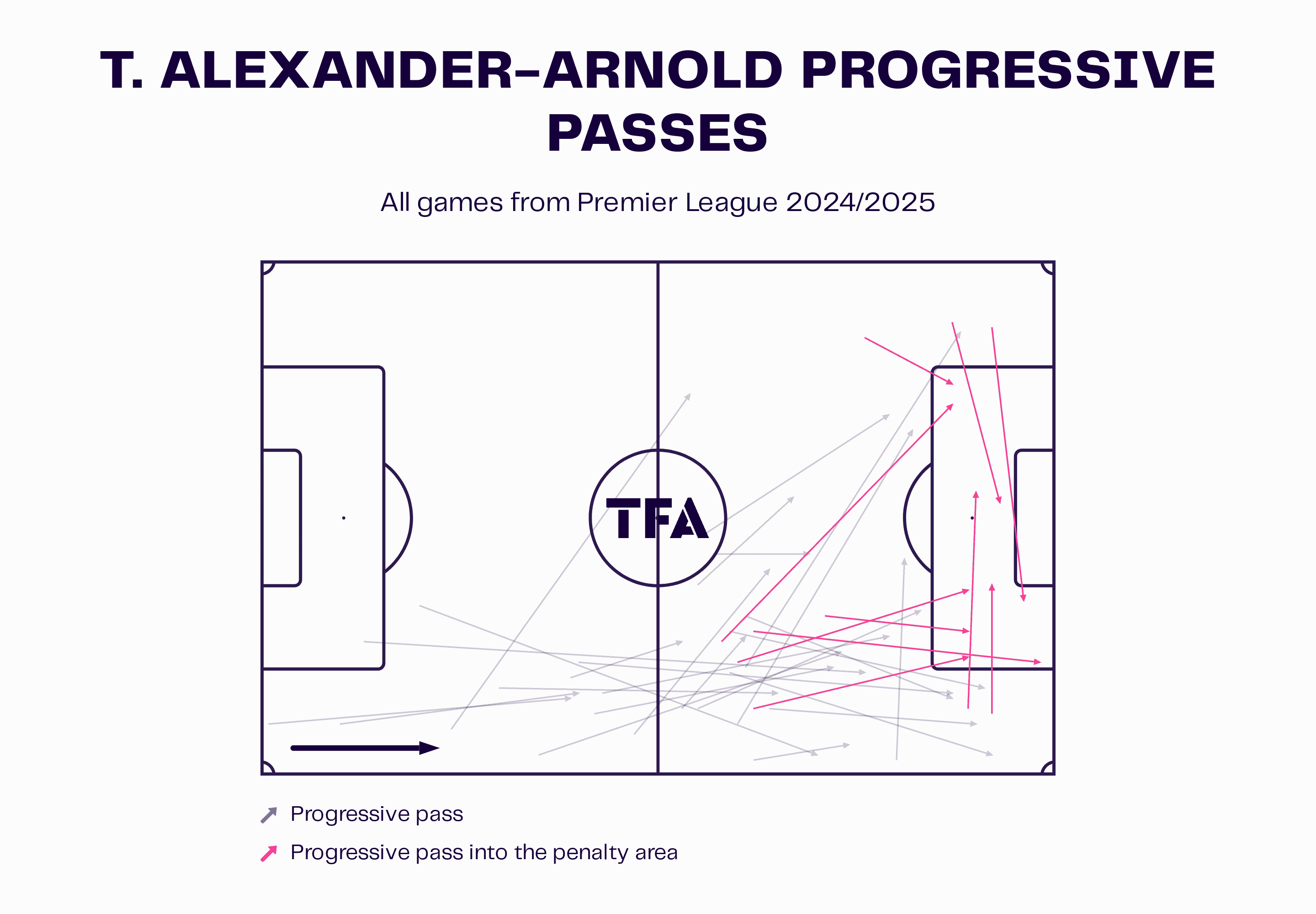
The right-back is prone to switching the play with diagonal passes covering considerable distances or feeding in teammates down the right-hand channel.
He often progresses play for his side into the penalty area or, at the very least, the attacking final third.
Alexander-Arnold has often showcased his ability in possession.
Having started his career in midfield at the Liverpool academy, his passing repertoire is evident both in transitional play and deadball situations.
His ability to pick out important passes has been evident if we consider the data since the 2019/20 season, for players to have featured for at least 10 90s in the full seasons and up to the available data at the time of writing for this campaign.

The bar plot shows the top ten players and the corresponding season for their key passes per 90 statistics in the Liverpool squad.
It is evident that Alexander-Arnold is a prominent figure on that list, featuring five times.
The data points to the right-back being a player who can pick out dangerous passes, but the fact that he has been consistent in playing such passes as the seasons have gone by showcases how he’s never been a flash in the pan.
With the exception of the 2023/24 campaign, Alexander-Arnold has produced the most key passes per 90 in each campaign since 2019/20 compared to his teammates.
Not only has the right-back been an important figure in spearheading attacking transitions, but he has also been heavily involved in Liverpool’s overall attacking play if we consider the xGChain statistics since the 2019/20 campaign.
The xGChain is quantified by considering all the possessions that a player is involved in and all the expected goal values that such possession leads to.
The subsequent expected goal value is attributed to each player in that possession chain, regardless of whether the player took the shot or started the possession chain that led to the eventual shot.
By summarizing the expected goal values for each player in each possession chain, we can start to get an idea of how involved a player is in attacking sequences.
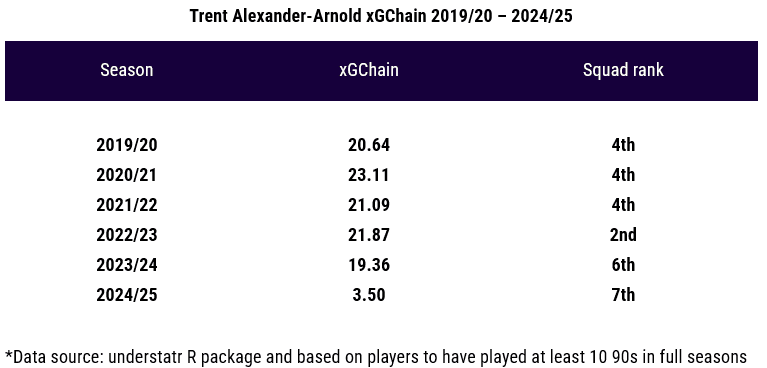
The table shows Alexander-Arnold’s xGChain value since the 2019/20 campaign, along with where this value ranked compared to his teammates at Liverpool in each of these seasons.
The consistently high rankings demonstrate that the England international has been an essential player in Liverpool’s attacking play.
Players who have had higher xGChain values than Trent over the seasons have included the likes of Salah, Sadio Mané, and Roberto Firmino.
However, all these players are forwards, and therefore, it’s anticipated that they will be involved in more goal-scoring opportunities, giving further weight to Alexander-Arnold’s involvement when in possession.
Moreover, Alexander-Arnold is a key figure in Liverpool’s defensive line and has strong possession-based qualities.
So far this campaign, Liverpool have the joint-best defence in the division, having only conceded once.
In four of the past five seasons, the Reds have featured within the top flight’s five best defences, and Alexander-Arnold has been practically an ever-present in those backlines.
He is not known as a tough-tackling defender.
Still, he has consistently been one of Liverpool’s highest performers for interceptions per 90 over the seasons, illustrating his reading for the game and his ability to cover his defensive line.
It hence further exemplifies Alexander-Arnold as an important piece of the Liverpool jigsaw.
Liverpool Performance Without Trent Alexander-Arnold
In the recent fixture against Nottingham Forest, Liverpool fans were given a glimpse of what the Merseyside outfit would look like without Alexander-Arnold lining up at right-back.
The 25-year-old started the game at right-back but was moved into central midfield on the hour mark as Liverpool tried to break down Forest’s defensive line.
The graphic below shows Liverpool’s shots prior to Alexander-Arnold’s positional switch.
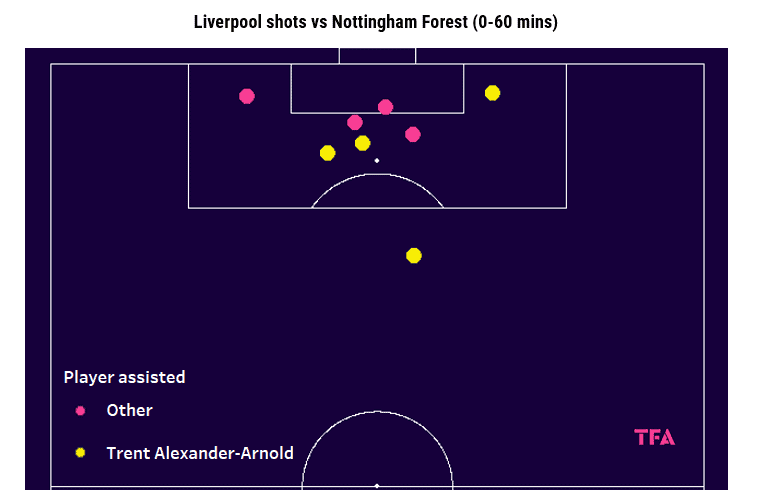
The plot shows that Liverpool was able to carve out decent opportunities, and notably, the yellow circles show the efforts assisted by Trent.
Given Trent was directly involved in 50% of Liverpool’s attempts at goal, it highlights his contribution.
In contrast, after the tactical switch into midfield, with Conor Bradley taking up the right-back role, Liverpool were less of a threat, as the graphic below testifies.
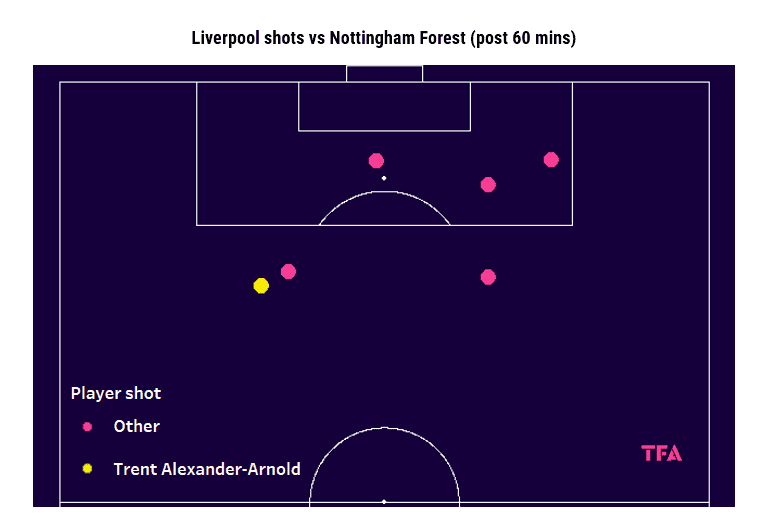
It is shown here that Alexander-Arnold was only directly involved in one of the goal attempts; the plot below shows that after the tactical switch, Liverpool carved out opportunities with lower expected goal values.
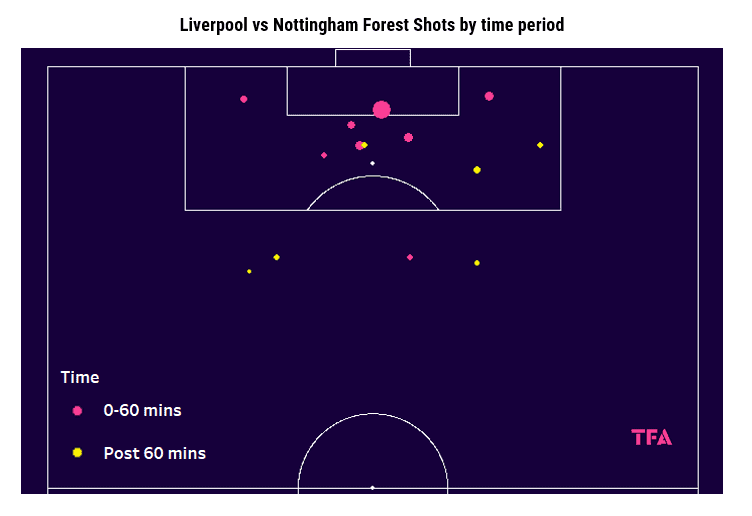
The tactical switch coincided with Forest coming into the game more and carving out their opportunities, particularly on the attacking left side that Bradley was marking.
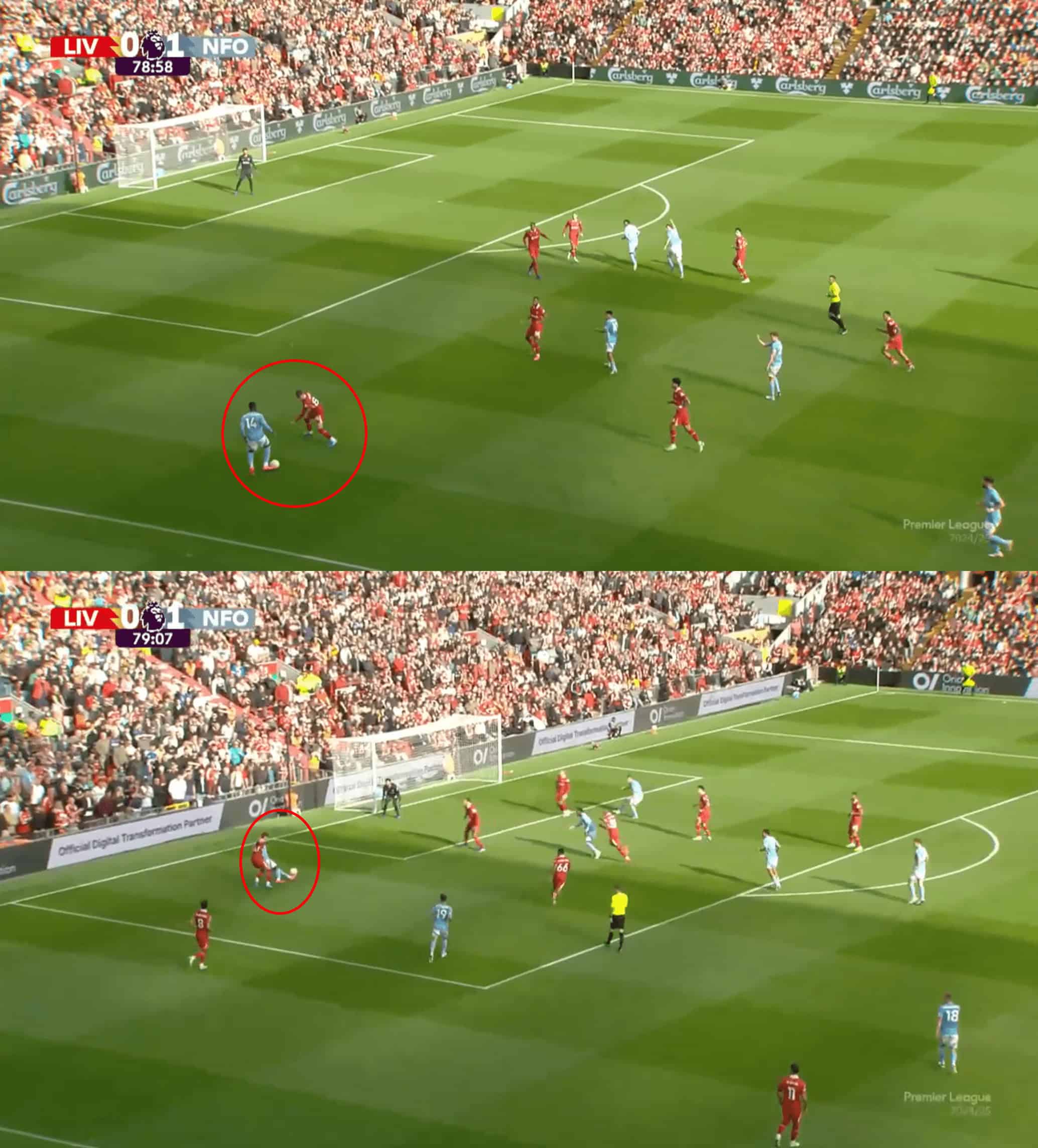
Callum Hudson-Odoi received possession here and, with his strength, got the better of Bradley to drive play forward into the penalty area.
Of course, this wasn’t the only time in the match that the former Chelsea man had the better of Bradley, as he cut inside to score the only goal of the game moments earlier.
For all the plaudits that Bradley has won with his senior appearances to date, he still remains a prospect, and it would be difficult for such a young prospect to fill the Alexander-Arnold void if he were to leave next summer.
In the example against Forest, Bradley’s inexperience was exposed, and there’s an argument that had Slot not opted to change Trent’s positioning, the match outcome may have been different.
This analysis has already shown that Alexander-Arnold’s importance to this Liverpool side is largely due to his ability in possession.
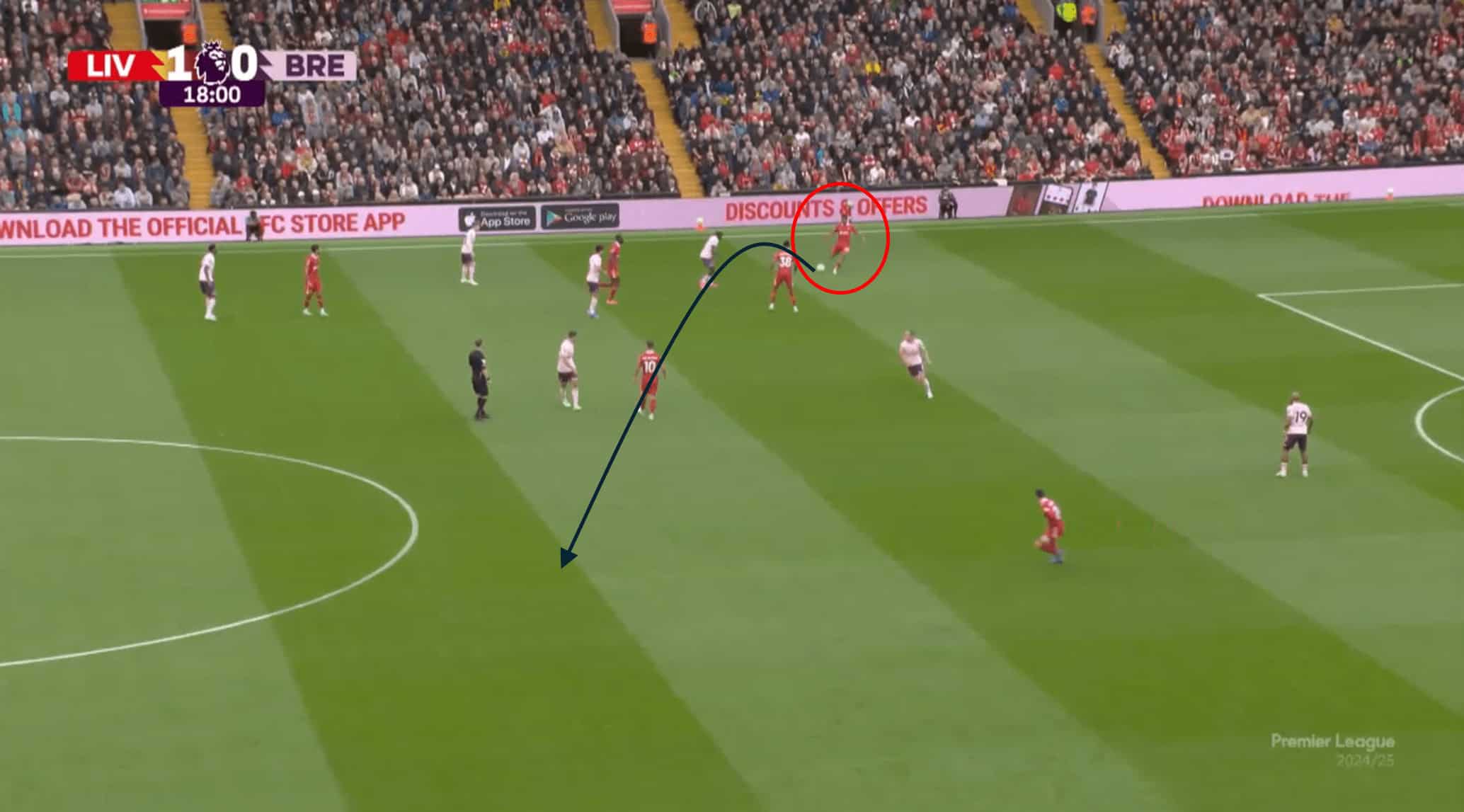
Against Brentford, his switch of play was effective in exploiting the space to allow the Reds to progress and bypass the press.
One simple pass executed well was the key in the transitional play when Liverpool was, in theory, confined within its own defensive territory.
Given the stature of a club like Liverpool and their reputation as one of the best teams in the Premier League, teams are much more likely to sit deeper, which is something we observed from Ipswich.
Ipswich Town Defensive Territory Map
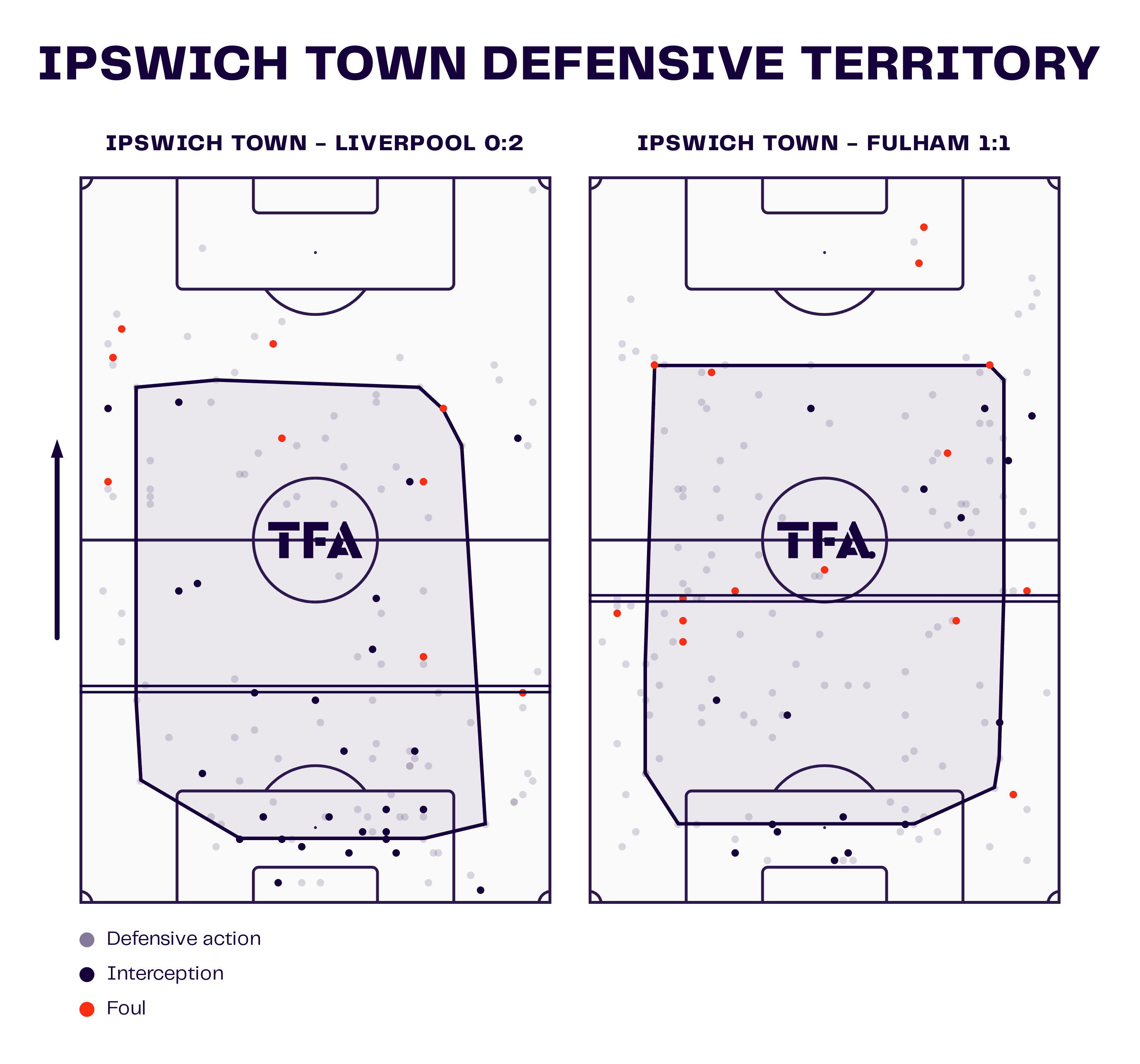
Kieran McKenna’s side kept a much deeper defensive line against the Reds than in their recent fixture against Fulham, demonstrating how Slot’s side will likely have to break down low blocks this campaign persistently.
The task in doing so is arguably an easier one with Trent in the side, as the right-back has averaged 0.86 through balls per 90 – the highest of any Liverpool player this season.
It may prove cheaper to turn to the market from a salary perspective to replace Alexander-Arnold, but with that comes no guarantee that Liverpool would be getting a player of the same calibre.
Conclusion
Alexander-Arnold has proven his worth to Liverpool as the seasons have gone by.
Regardless of ability, many Liverpool fans would likely want to see one of their own stay on sentimental grounds.
He may not have the reputation from a defensive perspective, but he adds so much to this Liverpool team when in possession.
Players’ salaries can be a topic of conversation in modern football, with much debate about a player’s value.
Based on this analysis, there is an argument that Alexander-Arnold should consider demanding a higher salary, especially as he approaches his prime years.
Liverpool looks to be in a position where they cannot afford to lose him.

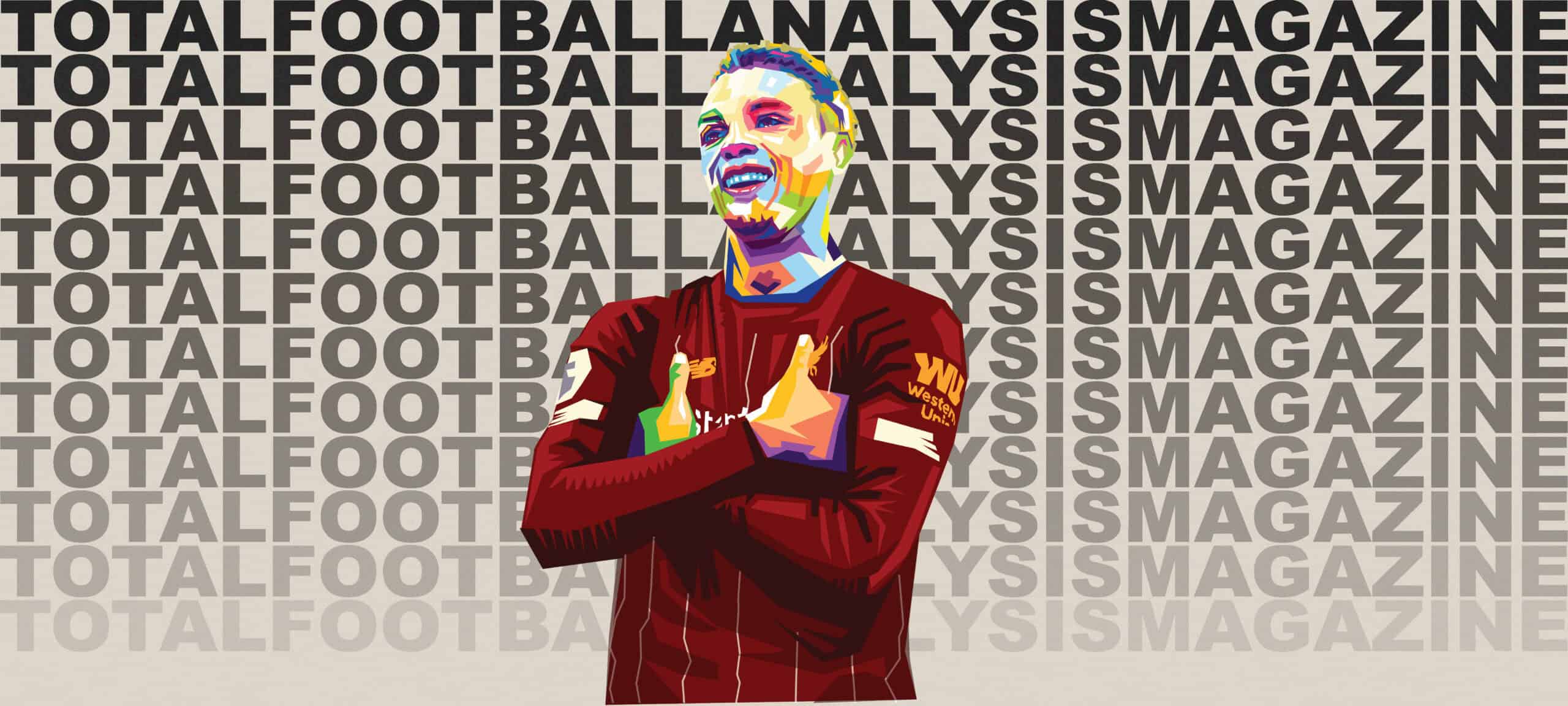




Comments